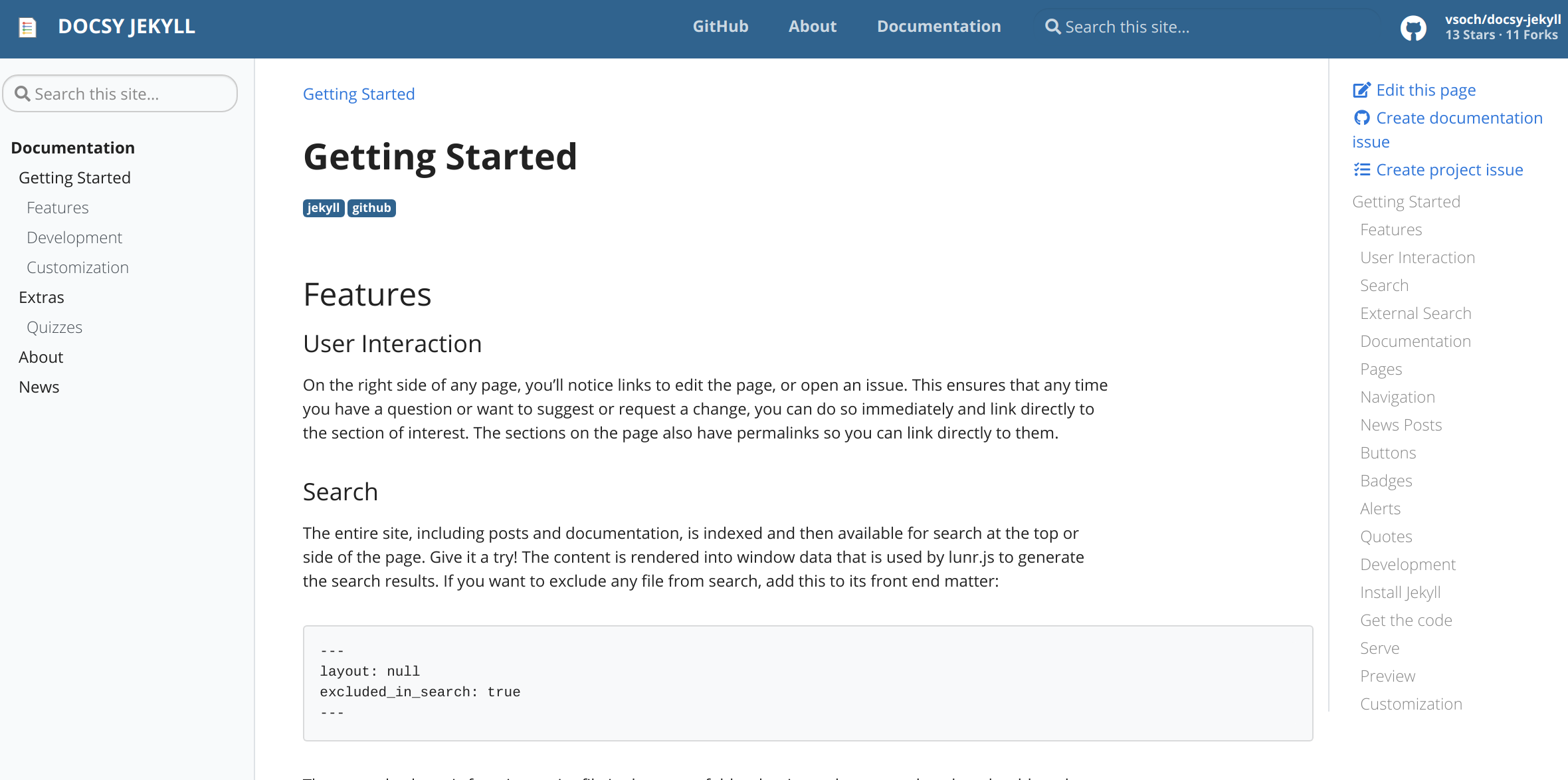https://github.com/vsoch/docsy-jekyll
A Jekyll version of the beautiful Docsy!
https://github.com/vsoch/docsy-jekyll
docsy hacktoberfest jekyll template
Last synced: 3 months ago
JSON representation
A Jekyll version of the beautiful Docsy!
- Host: GitHub
- URL: https://github.com/vsoch/docsy-jekyll
- Owner: vsoch
- License: apache-2.0
- Created: 2019-07-26T21:14:48.000Z (almost 6 years ago)
- Default Branch: master
- Last Pushed: 2023-08-17T14:41:29.000Z (almost 2 years ago)
- Last Synced: 2025-03-30T04:11:07.991Z (3 months ago)
- Topics: docsy, hacktoberfest, jekyll, template
- Language: CSS
- Homepage: https://vsoch.github.io/docsy-jekyll/
- Size: 2.17 MB
- Stars: 200
- Watchers: 8
- Forks: 142
- Open Issues: 5
-
Metadata Files:
- Readme: README.md
- Changelog: CHANGELOG.md
- License: LICENSE
Awesome Lists containing this project
- awesome-starred - vsoch/docsy-jekyll - A Jekyll version of the beautiful Docsy! (hacktoberfest)
README
# Docsy Jekyll Theme
[](https://circleci.com/gh/vsoch/docsy-jekyll/tree/master)


This is a [starter template](https://vsoch.github.com/docsy-jekyll/) for a Docsy jekyll theme, based
on the Beautiful [Docsy](https://github.com/google/docsy) that renders with Hugo. This version is intended for
native deployment on GitHub pages. The original [Apache License](https://github.com/vsoch/docsy-jekyll/blob/master/LICENSE) is included.
## Changes
The site is intended for purely documentation, so while the front page banner
is useful for business or similar, this author (@vsoch) preferred to have
the main site page go directly to the Documentation view. Posts
are still provided via a feed.
## Usage
### 1. Get the code
You can clone the repository right to where you want to host the docs:
```bash
git clone https://github.com/vsoch/docsy-jekyll.git docs
cd docs
```
### 2. Customize
To edit configuration values, customize the [_config.yml](https://github.com/vsoch/docsy-jekyll/blob/master/_config.yml).
To add pages, write them into the [pages](https://github.com/vsoch/docsy-jekyll/blob/master/pages) folder.
You define urls based on the `permalink` attribute in your pages,
and then add them to the navigation by adding to the content of [_data/toc.myl](https://github.com/vsoch/docsy-jekyll/blob/master/_data/toc.yml).
The top navigation is controlled by [_data/navigation.yml](https://github.com/vsoch/docsy-jekyll/blob/master/_data/navigation.yml)
### 3. Options
Most of the configuration values in the [_config.yml](https://github.com/vsoch/docsy-jekyll/blob/master/_config.yml) are self explanatory,
and for more details, see the [getting started page](https://vsoch.github.io/docsy-jekyll/docs/getting-started)
rendered on the site.
### 4. Serve
Depending on how you installed jekyll:
```bash
jekyll serve
# or
bundle exec jekyll serve
```
**NOTE:** If the above serve command throws an error saying `require': cannot load such file -- webrick (LoadError)` try to run `bundle add webrick` to automatically add the webrick gem to your Gemfile, or manually add `gem "webrick"` line to the Gemfile and then run the serve command again.
### 5. Run as a container in dev or prod
#### Software Dependencies
If you want to run docsy jekyll via a container for development (dev) or production (prod) you can use containers. This approach requires installing [docker-ce](https://docs.docker.com/engine/install/ubuntu/) and [docker-compose](https://docs.docker.com/compose/install/).
#### Customization
Note that the [docker-compose.yml](docker-compose.yml) file is using the [jekyll/jekyll:3.8](https://hub.docker.com/r/jekyll/jekyll/tags) image. If you want to make your build more reproducible, you can specify a particular version for jekyll (tag). Note that at the development time of writing this documentation, the latest was tag 4.0.0,
and it [had a bug](https://github.com/fastai/fastpages/issues/267#issuecomment-620612896) that prevented the server from deploying.
If you are deploying a container to production, you should remove the line to
mount the bundles directory to the host in the docker-compose.yml. Change:
```yaml
volumes:
- "./:/srv/jekyll"
- "./vendor/bundle:/usr/local/bundle"
# remove "./vendor/bundle:/usr/local/bundle" volume when deploying in production
```
to:
```yaml
volumes:
- "./:/srv/jekyll"
```
This additional volume is optimal for development so you can cache the bundle dependencies,
but should be removed for production.
#### Start Container
Once your docker-compose to download the base container and bring up the server:
```bash
docker-compose up -d
```
You can then open your browser to [http://localhost:4000](http://localhost:4000)
to see the server running.
> Node : changes `baseurl: ""` in _config.yml when you are running in local and prod according to the requirement.